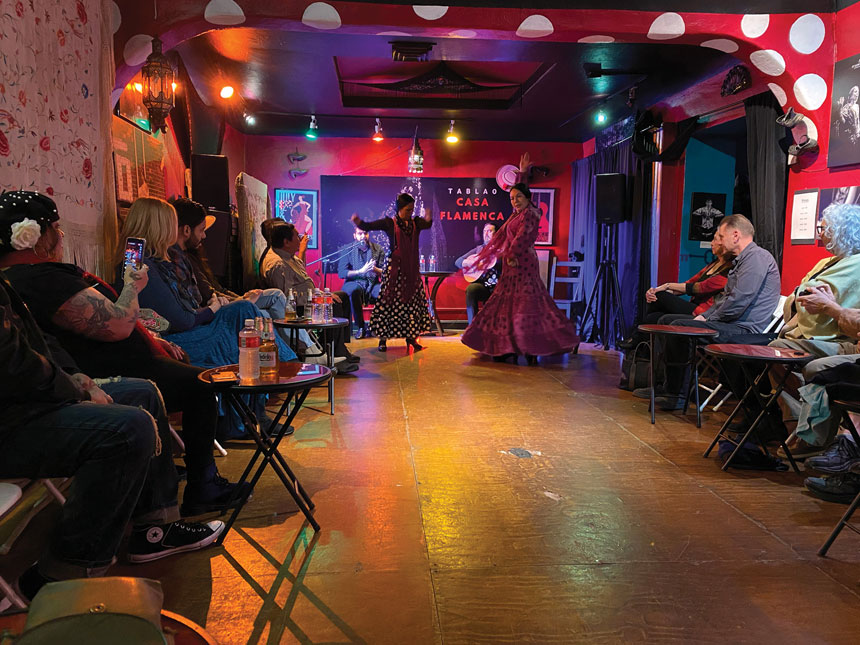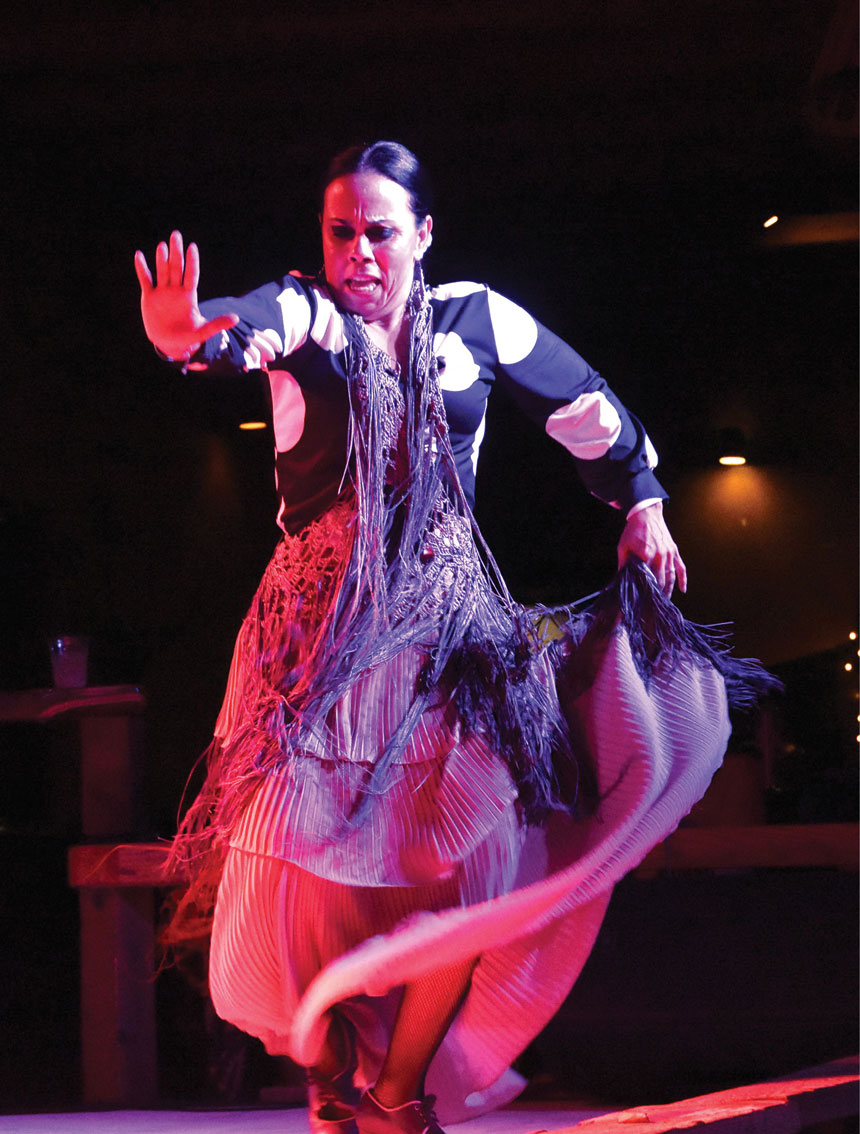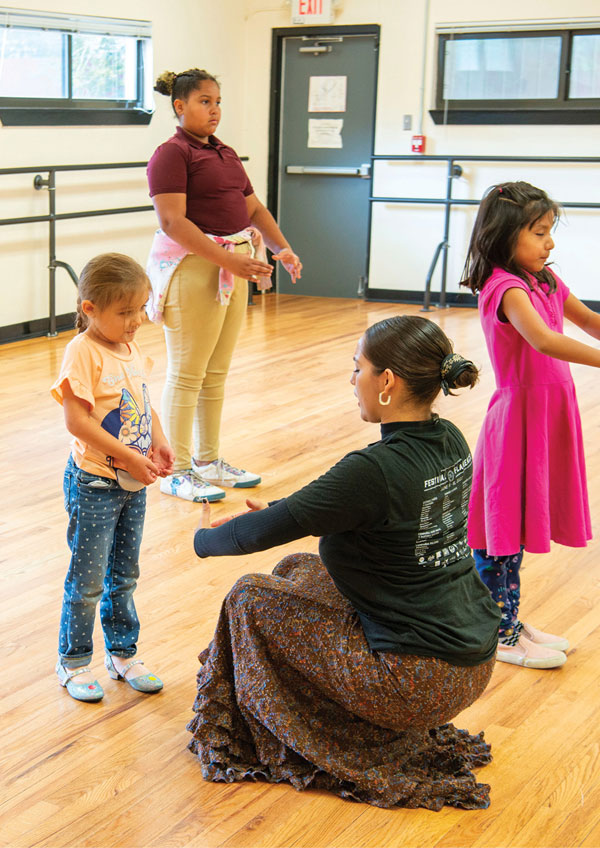The guitarist strummed a lively Spanish flamenco tune in a rapid rush of notes as his fingers flew across the strings. Next to him, the male singer began the cante, the song, which is the essence of the art form. His deep melodic voice conveyed a full range of passionate emotions — sadness, pain, joy, love — as he softly lamented, wailed, and powerfully expressed the song’s story to the audience.
In a setting no bigger than an average living room space, about 40 folding chairs, the durable plastic type that are commonly used at family parties or community events, lined the back walls of the room in a U shape. People of all ages and sizes filled the seats, motionless as the sounds of flamenco music resonated within the packed space of the tablao.
A tablao is a venue for flamenco shows; it’s not a large theater. A tablao is typically an intimate setting with a wooden stage for the artists to perform on, like a small nightclub or café. The audience normally sits at scattered cocktail or café tables facing the stage.
But this tablao was different. We were not separated from the performers by a raised stage; we shared the same floor. Our chairs left enough space in the middle so that they could dance right in front of us.
Suddenly, a woman wearing a long red dress entered the room, her sleek hair pulled back in a bun adorned with flowers. She swept past me, her ruffled skirt swishing with each step. Her feet drummed against the wood floor, creating a staccato sound. Each twist, turn, and twirl brought her closer to the guitarist and singer. I, like everybody else in the room, was transfixed, our eyes and ears at full attention, watching and listening to the trinity of artistic interplay happening before us.
I’ve been lucky enough to get front-row seats at performance arts events before, but nothing like this. I wasn’t accustomed to being within a few feet of a performer. Here, as an observer, I was on stage too. I felt the floor vibrate with every percussive stomp of the bailaora (female Flamenco dancer) with her energetic zapateado — a Spanish term for creating rhythms with the feet.
Later, Carmen Montes, the executive and artistic director of Casa Flamenca, the flamenco nonprofit organization where I watched the show, tells me, “There are caves in Granada, Spain, where flamenco is presented the way we do, with people sitting around the walls. We try to bring that same essence where flamenco is literally in your face. It’s a very unique experience.”

For an hour and a half, I was transported to a Spanish flamenco tablao in Andalusia, though physically I was far from it. I was in the southwestern United States in Albuquerque, New Mexico, where over the past 100 years, the art form has flourished, establishing deep roots in the state.
Flamenco has become a vibrant part of the cultural voice of New Mexico, so much so that Albuquerque — which hosts the largest flamenco festival outside of Spain — is recognized as the flamenco capital of North America.
Like the threads of a colorful and intricate tapestry, Spanish culture and traditions were woven into New Mexican society long before it became a state in 1912. Even before the first English settlers inhabited Virginia in 1607, the Spanish had already explored and claimed, and in some cases colonized, much of the southwestern territory of America. New Spain, what is now known as Mexico, was the launching pad for a number of expeditions into the far northern territory of the Spanish Empire.
In 1540, the Spanish conquistador Francisco Vázquez de Coronado set off from Compostela, New Spain, in search of gold, following trails formed by the indigenous people who had inhabited the lands for millennia. Coronado led his party deep into the interior on a route that became known as the Camino Real (“Royal Road”). In 1598, roughly half a century later, upon orders from the Spanish Crown, Juan de Oñate led a group of 200 soldier-colonists from Zacatecas into Nuevo Mexico. The expedition traveled along the Rio Grande, which stretches north into modern-day Colorado, creating settlements along the way.

These migration routes were also established trade routes that connected Central America with Mexico and North America. For 400 years the Camino Real was bustling with diverse ethnic groups seeking to settle or trade within the lands north of Mexico. There were not only Spaniards, says Marisol Encinias, executive director of the National Institute of Flamenco (NIF) in Albuquerque. It was a mix of people from different countries, many from lower classes, who brought with them their cultural ideas and traditions. There were people of Mexican indigenous heritage, those of African ancestry, and Spaniards who were actually gitanos — Romani from Southern Spain, primarily Andalusia, who were once disparagingly known as gypsies.
This confluence of cultures created an exchange of ideas, music, and dance and made its way north into modern-day New Mexico. Encinias explains that many songs and traditional dances of today have a connection to this time before flamenco as a form even existed.
The same type of cultural fusions happened in southern Spain, too. It was here, in the late 19th century, that flamenco proper took root, specifically among the gitano population of Andalusia, as a way to artistically express what they were feeling during a tumultuous time. It’s this chrysalis of dance, disparate traditions, shared hardships, and music that took flight as an art form — emerging as flamenco. “It’s an incredibly complex musical hybrid that is really beautiful,” says Encinias.
Learned within the family and passed down through generations, the music and dance form communicated and described their angst, joy, pain, and suffering.
At the end of the 19th century, small nightclubs in Spain called café cantatas started featuring flamenco musicians, with singers and dancers on stage. Curious travelers, locals, and aficionados interested in the emerging art form filled the venues.
During the early part of the 20th century, Spanish communities in New Mexico held local fiestas to celebrate their heritage with folkloric dances and songs performed in the plazas. Though the dancing was not quite flamenco, there were certain elements that resonated as flamenco style. It wasn’t until the 1940s that flamenco as a professional art form really took off in the United States. Jose Greco and his Spanish Ballet created elaborate touring productions showcasing flamenco dancers in colorful costumes with theatrical set designs, offering audiences a chance to attend professional flamenco productions on the big stage.
As the art form gained recognition throughout the latter 20th century, other flamenco artists and companies gained popularity across the States. Two of the most celebrated were from New Mexico: Vicente Romero studied and toured in Spain with Greco and is credited with bringing the fiery style of Gitano Flamenco to New Mexico in the 1960s. He and Maria Benitez, a talented Spanish dancer, performed and toured together for years before eventually setting off on their own. Both were flamenco legends. Benitez split her time performing in New York and Santa Fe, where she founded the Institute for Spanish Arts that offered flamenco classes and performances.
Other educational opportunities to learn flamenco guitar, singing, and dance began popping up across the state. “I was very influenced in my life by my mother and my grandmother as educators,” says Encinias, who along with her brother Joaquin grew up dancing at their grandmother’s dance academy in Albuquerque. Besides instruction in ballet, modern, jazz, and tap dancing, she recalls, her grandmother taught a variety of Spanish classical dance forms, including flamenco. “My brother and I studied flamenco with my grandmother and with my mother.” Their mother, Eva Encinias-Sandoval, is another flamenco legend of New Mexico and is considered a matriarch of the flamenco family.

Of her many accolades, in 2022 Eva Encinias-Sandoval was honored as a National Heritage Fellowship recipient by the National Endowment for the Arts for her dedicated work in preserving the culture of flamenco in the United States. Without a doubt, she has been a tour de force in promoting and developing flamenco educational programs in New Mexico for more than 40 years.
As a dance instructor at the University of New Mexico in the 1980s, she was asked by the university to develop a concentration of flamenco in the Department of Theater and Dance. To date, UNM is the only accredited university in the United States that offers a dance degree with a concentration in flamenco.
That was just a stepping stone to expanding the art of flamenco on a larger scale. She then founded the NIF in 1982 with the intent to promote the art of flamenco by providing a mix of educational and cultural programming. This included the creation of the annual Festival Flamenco Alburquerque — with a nod to the traditional spelling of the city’s name — which has become the largest and most renowned flamenco festival outside of Spain. This year marks the 37th festival of this prestigious week-long flamenco event, where performances, workshops, world premiere shows, and international performers and companies will fill Albuquerque with the sounds of flamenco.
Both of Eva Encinias-Sandoval’s children, Marisol Encinias and Joaquin Encinias, are instrumental in fulfilling the legacy to perpetuate flamenco’s history, artistry, and culture through their work at the NIF. As executive director, Marisol sees much of her role as creating a community and foundation where the art can continue to exist well into the future. Her brother Joaquin, a respected choreographer, is artistic director of the Conservatory of Flamenco Arts, the dance and music school of the NIF. He’s also artistic director of Yjastros: The American Flamenco Repertory Company, the only professional flamenco repertory company in the United States.
Through their work with the NIF, the Encinias family has opened the door for flamenco artists in New Mexico to thrive while helping audiences recognize the value of the art form throughout the United States.
A large part of what keeps the flame of flamenco alive is the rich community programs so tirelessly offered by flamenco professionals in Northern New Mexico, from Albuquerque to Santa Fe. Outreach programs provide access to the culture and music of flamenco to all manner of people, including underprivileged youth, remote communities, and economically challenged families.

(Ungelbah Davila)
In Albuquerque, Carmen custcu of Casa Flamenca created a free Family Sunday event, offered once or twice a month and sponsored by the City of Albuquerque Arts and Culture and New Mexico Arts, in which the community can take part in an entertaining and cultural flamenco experience. “The program is mostly geared toward young children and their families,” says Montes. The outdoor space, Tablao al Aire, is alive with the strumming of guitarists and energy of fleet-of-foot dancers. It gives the community a chance to learn more about the traditions of flamenco.
Casa Flamenca’s motto is “Flamenco Is for Everyone.” They not only offer tablao flamenco performances with visiting artists from Spain but also host a range of programs and classes for anyone who wants to learn the music and dance of flamenco.
Close to Montes’s heart is what she calls Casa Flamenca’s “special programs” — like the one offered at a local hospital for children with cerebral palsy. Through techniques of flamenco, she worked on getting the kids to move in different ways and to work on posture and strength. She also developed a flamenco program for children with Down syndrome. “It was great to see the parents at their final presentation. They saw their kids remembering how to do things to dance and have fun,” she says.
It’s a lot to pack into a seven-day work week. Montes acknowledges that it’s a labor of love: “I have a dedication to an art form that I love and have a lot of respect for. I want to share that with the community.”
Marisol Encinias firmly believes that the arts are a powerful thing that more people should have access to. She has developed ways for the NIF to reach more people, like an initiative called Flamenco in Your Neighborhood. “It’s a community arts engagement where we are going out to different parts of rural New Mexico in areas with fewer resources to share flamenco with those communities.” Free flamenco dance and music classes are offered to kids for eight weeks. There’s a free community class every week for children, followed by a technique class for adults, offered at minimal cost. “At the end of the program,” Encinias says, “I see the kids dancing across the floor with their arms held high above their head. There’s a sense of empowerment as they engage in the culturally relevant art form.”
When someone travels to New Mexico, Encinias is hopeful that they will go see a flamenco performance or event. “Every time somebody supports the work that we’re doing, they are supporting part of the movement.”
Gigi Ragland is a travel journalist based in Longmont, Colorado. Her stories cover outdoor soft adventure, culture, nature, and good eats. Her credits include AARP, Conde Nast Traveler, National Geographic, and more. Follow her global gallivanting on Instagram.
This article is featured in the May/June 2024 issue of The Saturday Evening Post. Subscribe to the magazine for more art, inspiring stories, fiction, humor, and features from our archives.
Become a Saturday Evening Post member and enjoy unlimited access. Subscribe now



